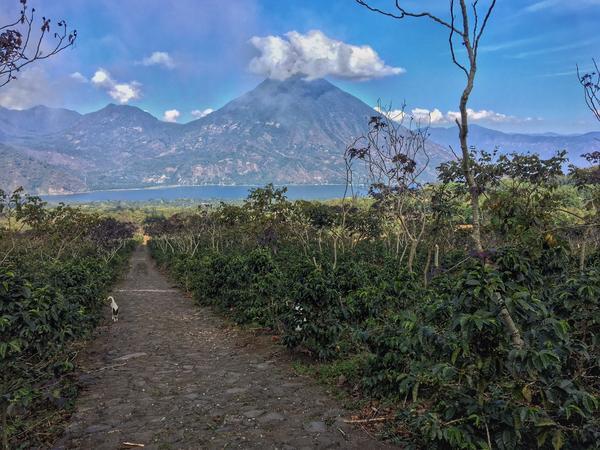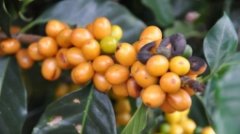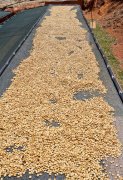The largest coffee cooperative in Costa Rica-Tarazu Cooperative Costa Rican Coffee hand

For professional baristas, please follow the coffee workshop (Wechat official account cafe_style)
The Tarazhu Cooperative in Costa Rica has stable washing quality and good flavor.
Medium and deep baking water washing treatment in Costa Rica
The traditional washing method is used to treat raw beans, which flows through the Rio Pirris River next to the treatment plant. Abundant and clean water sources provide good conditions for washing treatment. Volcanic soil, the careful care of farmers, high-mature berries, clean water, a century-old washing process that boasts, and the final European treatment process to completely remove defective beans by hand, ensure that the flavor of each cup of coffee will reveal its introverted demeanor in unexpected purity.
Costa Rica Tarraz ú Coope Tarrazu RL
The largest coffee cooperative in Costa Rica has stable quality and good flavor.
Founded in 1970, the Tarazu Cooperative (CoopeTarrazu RL) has since become the largest coffee cooperative in Costa Rica and has become a major contributor to the economic development of the town of San Marcos in the Tarazu region, as the processing plant is nearby, and each year the cooperative employs about 10000 people directly in coffee production and support. The coffee garden that joins the farmers is mainly on the volcanic hillside with an average elevation of about 1500 meters behind the treatment plant, with an annual rainfall of 3200 mm. The varieties are Caturra and Catuai. From November every year, cooperative farmers tour the coffee garden irregularly, picking red ripe fruits by hand and transporting them to the treatment plant below. The traditional washing method is used to treat raw beans, which flows through the Rio Pirris River next to the treatment plant. Abundant and clean water sources provide good conditions for washing treatment. Volcanic soil, the careful care of farmers, high-mature berries, clean water, a century-old washing process that boasts, and the final European treatment process to completely remove defective beans by hand, ensure that the flavor of each cup of coffee will reveal its introverted demeanor in unexpected purity.
Palate description: acidity of nuts, caramel and black cherries, balanced and supple, dark chocolate and creamy.
36 aromas of coffee: dark chocolate, trees, vanilla, maple syrup, hazelnut, fried walnut
Important Notice :
前街咖啡 FrontStreet Coffee has moved to new addredd:
FrontStreet Coffee Address: 315,Donghua East Road,GuangZhou
Tel:020 38364473
- Prev

Introduction of 21 winners of Las Cagis Farm in 2010 Columbia COE Competition
For the exchange of professional baristas, please follow the Coffee Workshop (official Wechat account cafe_style) 2010 Colombia COE National Coffee Competition 21st Las Cochas Las Cadges Farm winner Colombia is currently the third largest coffee producer in the world, originally second only to Brazil, but in recent years Vietnamese coffee, which specializes in the production of Robusta stout beans, has surpassed Colombia's runner-up.
- Next

Costa Rican Conqueror Coffee Bean Wash Costa Rican Fine Coffee Bean Brewing Advice
Professional barista exchanges, please pay attention to coffee workshop (Weixin Official Accounts cafe_style) Costa Rican conquerors come from Hacienda La Minita estate in the famous Tarraz producing area. Due to the excellent geographical environment and microclimate in the estate, the beans of La Minita estate taste more balanced and aromatic than coffee in other producing areas. This kind of goth
Related
- Detailed explanation of Jadeite planting Land in Panamanian Jadeite Manor introduction to the grading system of Jadeite competitive bidding, Red bid, Green bid and Rose Summer
- Story of Coffee planting in Brenka region of Costa Rica Stonehenge Manor anaerobic heavy honey treatment of flavor mouth
- What's on the barrel of Blue Mountain Coffee beans?
- Can American coffee also pull flowers? How to use hot American style to pull out a good-looking pattern?
- Can you make a cold extract with coffee beans? What is the right proportion for cold-extracted coffee formula?
- Indonesian PWN Gold Mandrine Coffee Origin Features Flavor How to Chong? Mandolin coffee is American.
- A brief introduction to the flavor characteristics of Brazilian yellow bourbon coffee beans
- What is the effect of different water quality on the flavor of cold-extracted coffee? What kind of water is best for brewing coffee?
- Why do you think of Rose Summer whenever you mention Panamanian coffee?
- Introduction to the characteristics of authentic blue mountain coffee bean producing areas? What is the CIB Coffee Authority in Jamaica?

